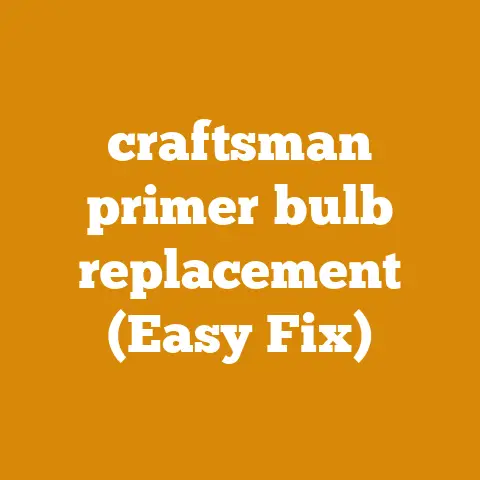Craftsman Chainsaw Leaks Bar Oil (4 Fixes to Try)
Imagine your chainsaw as a loyal companion, always ready for the next task.
But even the best companions have their off days, like when your Craftsman chainsaw starts leaking bar oil.
It’s messy, frustrating, and can seem like a daunting problem.
But don’t worry—let’s walk through this together and find a fix that works.
Understanding Why Your Chainsaw Leaks Oil
Chainsaws are complex machines, and understanding why they leak oil can feel like solving a mystery.
The issue might be as simple as a loose oil cap or something more intricate like a faulty seal.
It’s important to approach this methodically.
Let’s explore potential causes in detail.
Potential Causes of Oil Leaks
- Damaged Oil Cap: A cap that doesn’t fit snugly can let oil escape.
- Worn-Out Oil Seal: Over time, seals wear out, leading to leaks.
- Clogged Oil Vent: A blocked vent can cause pressure build-up and force oil out.
- Improper Storage: Storing the chainsaw incorrectly can exacerbate leaks.
Safety First!
Before diving into any repairs, let’s prioritize safety. Working with chainsaws requires caution.
- Protective Gear: Always wear gloves to protect your hands from sharp edges, goggles to shield your eyes from debris, and sturdy boots for foot protection.
- Chainsaw Off: Ensure the chainsaw is completely off and disconnect the spark plug to prevent accidental starts.
- Well-Ventilated Area: Work in an open space to avoid inhaling fumes.
Personal Anecdote:
I remember once rushing into fixing my saw without gloves.
A tiny metal shard embedded itself in my finger—lesson learned!
Always prioritize safety gear.
Tools & Materials You’ll Need
To tackle these fixes, gather the following:
- Screwdrivers: Both Phillips and flathead types for various screws.
- Replacement Parts: Oil cap or seal if you suspect they’re faulty.
- Cleaning Supplies: Rag, soap, water for cleaning components.
- Oil Pan or Absorbent Pad: To catch and dispose of any leaking oil.
Tip Box:
Invest in quality tools; they last longer and make repairs easier.
Fix #1: Check the Oil Cap
A leaky oil cap is one of the simplest fixes but often overlooked.
Step 1: Inspect the Cap
Begin by examining your oil cap closely.
Look for cracks or deformation.
A cap that doesn’t fit well can let oil seep out easily.
Step 2: Replace if Necessary
If you spot any damage, it’s time for a replacement.
Don’t skimp on this—get a genuine Craftsman cap for the best results.
Step 3: Reattach Securely
Once replaced, ensure the new cap is screwed on tightly to prevent future leaks.
Story Time:
Years ago, I had a chainsaw that constantly leaked.
After much frustration, I realized the cap was misthreaded—a simple oversight that taught me to always double-check my work!
Fix #2: Examine the Oil Seal
The oil seal plays a crucial role in keeping everything tight and leak-free.
Step 1: Locate the Oil Seal
The oil seal is usually positioned near the oil pump.
You may need to remove some parts to access it.
Step 2: Inspect for Damage
Check for any signs of wear such as cracks or brittleness.
A compromised seal won’t hold oil well.
Step 3: Replace Damaged Seals
When replacing, ensure you use high-quality seals designed for Craftsman chainsaws to maintain efficiency.
Warning:
Avoid using excessive force when removing or replacing seals—it can cause further damage!
Fix #3: Clean the Oil Tank Vent
A clogged vent can lead to unnecessary pressure build-up.
Step 1: Identify the Vent Location
The vent might be a small hole near the oil tank or cap—check your manual if unsure.
Step 2: Clean Thoroughly
Gently clean with a rag or brush to remove dirt and debris.
Avoid using sharp objects that could enlarge or damage the vent hole.
Troubleshooting Tip:
If your chainsaw continues to leak after cleaning, there might be additional blockages deeper in the system needing professional attention.
Fix #4: Proper Storage Practices
How you store your chainsaw affects its overall condition and leakage issues.
Step 1: Drain Excess Oil
Before storing, drain out excess oil into an oil pan or absorbent pad.
This reduces residual pressure within the tank.
Step 2: Store Upright and Securely
Keeping your chainsaw upright prevents oil from pooling at one end and minimizes leakage risks.
Step 3: Consider Long-Term Storage Solutions
For extended periods, consider removing the bar and chain, clean them thoroughly before storage.
Personal Tip:
I keep my chainsaws on a dedicated shelf with absorbent pads underneath—just in case there’s any leakage!
Addressing Common Questions & Concerns
Let’s tackle some common queries that might pop up:
Q: My chainsaw leaks only when stored—why?
A: Gravity can pull oil through small gaps when stored improperly.
Adjusting storage habits often helps.
Q: Can I substitute parts with non-Craftsman brands?
A: While possible, it’s best to stick with Craftsman-specific parts for optimal performance and compatibility.
Q: How frequently should I check for leaks?
A: Regularly inspect your chainsaw before each use—early detection saves hassle later!
Final Thoughts and Next Steps
Maintaining your chainsaw involves more than just fixing leaks—it’s about ensuring it’s ready for every task without hiccups.
Regular maintenance checks, proper storage solutions, and timely part replacements are key to extending its lifespan.
Next time you spot a leak, remember these steps—addressing minor issues early prevents bigger problems down the line.
Keep those tools sharp, stay safe, and enjoy your woodworking ventures!
FAQ Section
Q1: What type of bar oil should I use?
A1: Always use manufacturer-recommended bar oil to maintain efficiency and prolong tool life.
Q2: How do I know if my oil seal needs replacing?
A2: Visible damage like cracks or excessive leaking are indicators it’s time for a new seal.
Q3: Is it normal for some oil to leak during operation?
A3: A small amount may leak due to vibrations—it’s excessive leakage that signals an issue.
Q4: Can temperature changes affect oil leakage?
A4: Yes, temperature fluctuations can cause oil expansion or contraction affecting leakage rates.
Store tools in stable environments when possible.
Remember, every tool has its quirks—understanding them makes us better at handling whatever comes our way!






